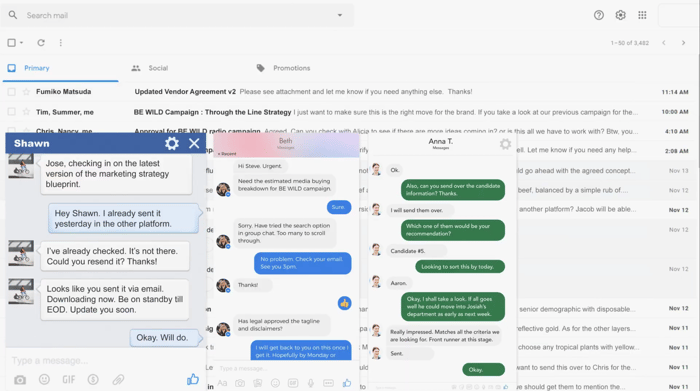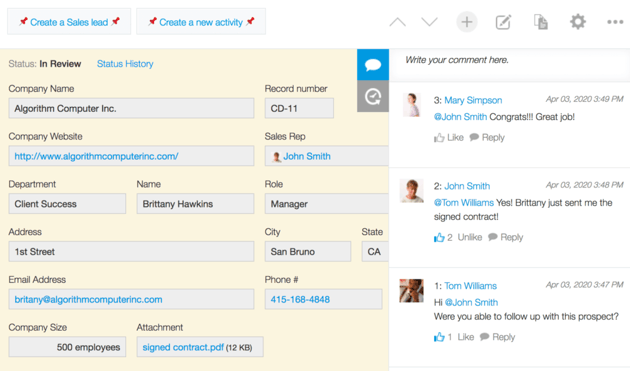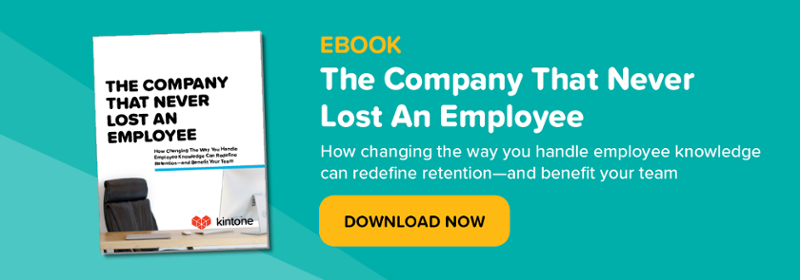Even before the Covid-19 lockdowns, digital communication tools were gaining popularity in the workplace for keeping productivity humming along.
What is the appeal for built-in chat tools versus a standalone app? Can too many communication channels hinder workflow? And what does the future of work look like, now that a global pandemic has permanently shifted how and where work happens?
First, let’s look at some numbers.
- A Stanford University study found that an astounding 42% of the U.S. labor force is working from home currently.
- The same research also found that, on average, about 51% of a given company’s workforce is able to effectively do their jobs remotely.
- According to the National Association for Business Economics, only 11% of survey respondents expect to see all staff members return to the office eventually.
Mio’s survey of chat and messaging apps reports a staggering 91% of companies are using at least two chat apps for work. On average, respondents are using 3.3 chat apps to communicate with colleagues.
Companies who have integrated effective communication tools into their systems have seen their employee retention rates increase by 450%, according to Goremotely.net.
Maybe this is just pointing out something that most of us feel like we already knew—remote work is here to stay. And with it? Video calls, more emails, and of course, chat apps.
From Fax to Slack: A Brief Look at Email in the Workplace
Just as email supplanted the postal service and fax machines as the gold standard in business communications, so too have enterprise chat apps arrived to carve out their niche as an indispensable tool for teams looking to share information quickly and easily. In order to find out where the future of business communications is headed, and why the answer is more integration, let’s take a quick look at how email got where it is today.
Despite the obvious advantages of email over paper communications, adoption of this new technology took decades. More than thirty years had passed from the implementation of ARPANET on university campuses until Hotmail, Yahoo Mail, and Gmail became the standard communication tools for our modern age. In fact, according to the Radicati Group’s research, close to half of the global population have an email address; there are over 3.8 billion email users worldwide, 347 billion emails are sent per day, and the average office worker receives about 124 emails daily.
So, email isn’t going anywhere any time soon. But it’s not often the most practical way to communicate, especially considering the expansion and standardization of remote work. Even with modern, streamlined interface design, the shortcomings of email make themselves apparent. Managing conversation threads and adding/removing members to a discussion via email is near impossible, and maintaining security of sensitive data is only as effective as individual adherence to handling protocols. The cybersecurity firm Cybint has found that 95% of cybersecurity breaches are caused by human error, and that email is one of the least secure ways to store data. 75% of your intellectual property is contained in emails. That information is too valuable to leave up to even the most fastidious among us. Security aside, emails have also been a massive time suck for office workers. A recent survey by Adobe found people in the workplace spend an average of 3.1 hours per day sending and checking their emails, amounting to 15.5 hours per week—and 20 weeks per year.
How Can Chat Do It Better?
Chat apps fill in the gaps that email leaves open. They’re a great tool for quick questions, group discussions, and sharing files. Many even include some form of video chat feature. Additionally, some chat apps allow companies to use their own servers to store discussions and files, giving more agency to companies when responding to cybersecurity threats, as well as decreasing the potential for security breaches.

Still, chat apps have their own pitfalls. Many of the standard, non-premium versions of these apps will put a limit on either the amount of data or time they’ll store your conversations. While keeping a searchable archive of your conversations might be easier with a chat app than with email, that information will eventually be lost anyway if you don’t pay the premium. Should an organization choose to host their own servers using one of the limited number of apps that allow it, they’ll need to put extra resources into securing and maintaining those servers as well.
READ ALSO: [eBook] The Company That Never Lost An Employee: How Changing The Way You Handle Employee Knowledge Can Redefine Retention—And Benefit Your Team
And in the cases of both email and chat, there’s the unfortunate effect that ‘app switching’ has on productivity. In a survey conducted by the software company Mavenlink, 73% of companies reported that employees spend more than an hour per day switching between business applications. According to research conducted by RingCentral, 63% of workers are toggling between apps ten times an hour.
To put this in perspective, this means that on average, two-thirds of knowledge workers are spending over ninety hours per year, just on switching between apps. Add to it the dissatisfaction that employees feel when they’re switching apps all day, and there’s a very real possibility that introducing a new chat app into the workplace could be causing new problems, even as it solves old ones.
The Case for Unified Communications
The latest trend in business communications is called unified communications (UC). Unified communication software platforms seek to integrate text and video chat, file sharing, conferencing, collaboration software, and business process integration (BPI) into a holistic piece of software that can centralize communications, improve data accuracy, and increase security.

An example of an integrated chat feature in Kintone.
When integrated with other software, chat has the potential to be so much more sophisticated than simple instant messaging. When chat can function as a file-sharing system and searchable archive, it has the potential to eventually (and I mean...eventually) supplant email as the chief method of conducting business communications.
A bold claim, to be sure, but there is one major reason why integrated communications have such strong potential. It’s an elegant solution to a quiet problem that no one really noticed until recently: separating information from its context removes most of that information’s value. By keeping conversations searchable and closely tied with the apps, records, and files being discussed, you can improve the searchability of any crucial information and its context.
Here are a few more important figures on this:
- The average interaction worker spends 20% of their week searching for internal information. (McKinsey Global Institute)
- 58% of employee knowledge is standard, and 42% is unique. This means an employee leaves the organization, your existing workforce would be incapable of doing 42% of that person’s job. (Panopto)
- Only 13% of employees report finding it “easy to get the knowledge and data they need to do their jobs well," while 60% find it “difficult, very difficult, or impossible.” (Panopto)
- 75% of an organization’s intellectual property is contained within email and messaging systems. (Osterman)
By integrating chat into the entire business process, you break down the silos of communication between departments, increase information sharing, and make it easier to turn unique employee knowledge into easily-searchable institutional knowledge.
Here’s an example of how this can work, given the appropriate software:
Before integrated chat, a manager might leave the company after five years. The vast majority of her “unique” knowledge is contained in her email archive, but how cost-effective is it to have someone try to search through every email for information they may not even know how to identify? So the archive sits on a server, and every time someone wants to know something related to her expertise, they continue to repeat work that she had already performed, while the exact knowledge they need sits, inaccessible on the digital archive shelf.
By selecting task management software with integrated chat, for instance, when that manager leaves, all of the conversations she had are associated with records that are archived and searchable. If she oversaw the development of a digital asset management system, then any questions related to the information architecture can be easily searched by her successor. If there is any sensitive information that her successor needs access to, the access permissions are already set by the record itself, so any information related to it is already appropriately confidential.
See the difference?
Bespoke Boilerplate Software
There are so many options when it comes to platforms with integrated chat, and each one does things a little differently. No matter what you go with, there will be a certain amount of systems engineering and information architecture to set up. Setting up naming conventions for files, creating standards for record keeping, and establishing permission hierarchies are just a few of the considerations you’ll need to make regardless of your choice.
That said, out-of-the-box solutions such as MS Teams, Twilio, and Google Workspace may be a good place to start for very small businesses with uncomplicated workflow processes. If you’re an independent graphic design company with three employees, you may not need much personalization.
Once a business grows to the point where there are multiple tasks, conversations, and workflows to handle at once, custom apps become a lot more appealing. There are all sorts of options out there, and not all of them are necessarily as daunting or expensive as you might think. In fact, you may find that you can save a lot of time, money, and headaches to just build something with integrated chat features yourself.
The Future is Integrated
Integrating chat directly into the software you use is the next step in streamlining business communications. If you still don’t believe it, take a look at Salesforce, the largest CRM service in the world. In December 2020, they purchased Slack—arguably the premier standalone business chat app—for $27.7 billion. Software giants recognize the need for integrated chat tools and stepping up to supply a fast-growing demand for enterprise businesses.
Finding The Right Tools For Your Future
If you're looking for software tools that can help unify your communications and data, we recommend taking a look at Kintone. Kintone is a workspace platform designed for collaboration--and we have the communication features to support it.
One of the biggest bottlenecks to effective team communication are processes that rely on memory. If your communication requires people to remember to share info rather than having it accessible by default, your process has gaps that will lead to communication breakdowns.
Kintone's unique set of collaboration tools help eliminate the problems hidden chats (like email chains or private Slack conversations) create by promoting visibility as a default. If a conversation doesn't need to be hidden, it isn't.
You can learn all about Kintone's integrated chat features here: Why You’ll Want Kintone’s Integrated Chat Features For Your Business
About the Author
Mark is an avid writer with a ton of experience in journalism, experience design, performance, and event production. He also has impeccable taste in music. He currently lives and works as a writer/editor in the SF Bay Area. When he's not working, he's probably either spinning records or scoring goals on a bike polo court near you.











